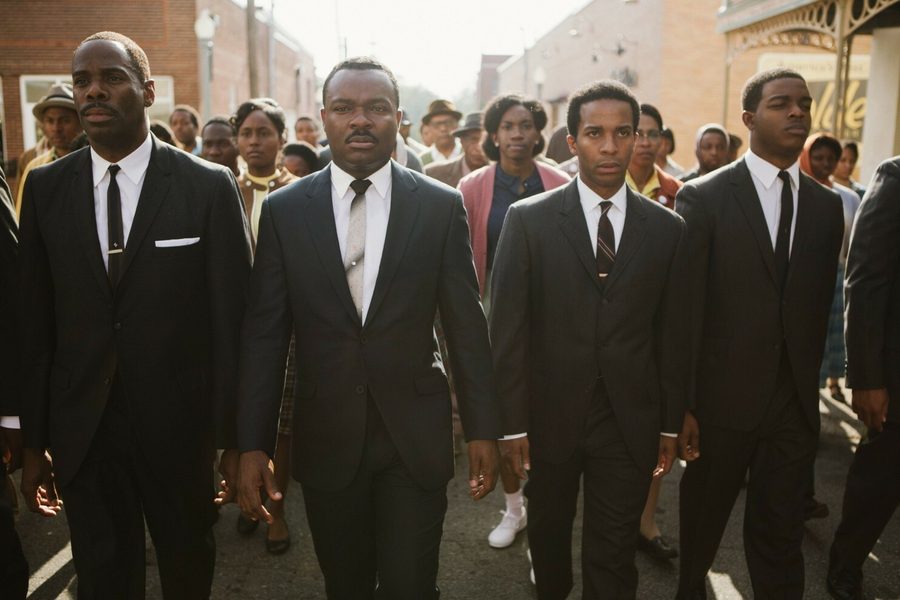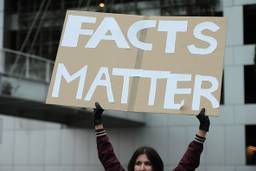Why Selma’s Critics Are Wrong About Civil Rights History
The film’s portrayal of Martin Luther King pushing President Lyndon Johnson to take action for justice apparently still makes some people uncomfortable.
Jim Naureckas

Even before it was released on Christmas Day, Selma was under attack.
In Politico’s “What Selma Gets Wrong,” LBJ Presidential Library director Mark Updegrove charged that the fictional film’s depiction of the epic voting-rights battle in the Alabama town “misses mightily in faithfully capturing the pivotal relationship — contentious, the film would have you believe — between [Martin Luther] King and President Lyndon Baines Johnson.” This served, Updegrove scolded, to “bastardize one of the most hallowed chapters in the civil rights movement by suggesting that the president himself stood in the way of progress.”
Johnson adviser Joseph Califano struck next in the Washington Post, complaining that the film “falsely portrays President Lyndon B. Johnson as being at odds with Martin Luther King Jr.” “In fact, Selma was LBJ’s idea,” Califano asserts. He asks of the filmmakers, “Did they feel no obligation to check the facts? Did they consider themselves free to fill the screen with falsehoods, immune from any responsibility to the dead, just because they thought it made for a better story?”
You even had Post columnist Richard Cohen lamenting that Selma is “a lie that tarnishes Johnson’s legacy to exalt King’s. This story needed no embellishment — and in my movie, King himself would’ve protested the treatment of Johnson. The greatness of King never depended on the diminishment of others.”
This is the same Richard Cohen who a little more than a year ago wrote that “people with conventional views must repress a gag reflex” when thinking about the interracial family of New York City Mayor Bill de Blasio. It’s fair to say there are other people who can better judge what Martin Luther King would have to say were he alive today.
Now, Selma is a work of fiction, not a documentary, as a disclaimer in the film’s credits goes out of its way to explain. Screenwriter Paul Webb and director Ava Duvernay do adjust certain historical events to tell a more powerful story; for example, the murder of the four girls in the Birmingham church happened in September 1963, not in late 1964, as the movie suggests. Such alterations are considered normal and unobjectionable in shaping history into a dramatic fictional narrative.
Op-eds, on the other hand, are supposed to stick to the actual facts. And the ones attacking Selma do far more to distort the reality of King’s relationship with Johnson than the fictional film does.
Take the idea that Johnson was never less than an enthusiastic partner of King in pushing for voting rights. Cultural historian Louis Menand described their actual relationship as a complex one, rooted in a Cold War context:
No elected official relishes having to deal with a charismatic popular leader; the usual forms of leverage are not effective. [John] Kennedy and Lyndon Johnson did not especially like dealing with King. But they needed him, because they needed a hero whose vision the democratic system could realize. The triumphalist narrative demanded it.
Menand’s account of LBJ and MLK’s conflicting priorities will sound familiar to anyone who has seen the film — and jarring to anyone who took Updegrove and Califano’s op-eds at face value:
Johnson recognized the need for additional voting-rights legislation, and he directed Nicholas Katzenbach, soon to be his attorney general, to draft it. “I want you to write me the goddamnest toughest voting rights act that you can devise,” is the way he put it. But then progress slowed. Johnson had the most ambitious legislative agenda of any President since F.D.R. (his idol), and he explained to King that he was worried that Southern opposition to more civil-rights legislation would drain support from the War on Poverty and hold up bills on Medicare, immigration reform, and aid to education. He asked King to wait.
King thought that if you waited for the right time for direct action (as nonviolent protests were called) you would never act.
Nor are the sometimes bitter tactical divisions an invention of the filmmakers. Here’s an account by Bruce Hartford in The Selma Voting Rights Struggle & March to Montgomery, which notes that the attempt to lead a voting-rights march from Selma to the capital in Montgomery was happening at the same time Johnson was first sending ground troops to Vietnam:
Behind the scenes, President Johnson pressures Dr. King to cancel the Tuesday march. … But … news stories and images of Marines wading ashore to “defend democracy” in Vietnam clash with images of real-life American democracy in action on the Edmund Pettus Bridge in Selma, Alabama. Johnson is furious, and he wants no risk of any repeat violence on Tuesday that might compete with his public relations strategy, or continue to give the lie to his “freedom” rhetoric.
If Johnson was actually the architect of the Selma strategy, as Califano asserts, you might wonder why civil rights activists were staging sit-ins at the Justice Department and the White House to protest the Johnson administration’s failure to protect marchers. These sit-ins were not invented by the filmmakers, nor was the anger LBJ expressed in response to them. Here’s Johnson afterwards telling his aide Bill Moyers what should be said to King — not from the movie script, but from a tape made by the White House recording system:
I would take a much tougher line than we’re going to with him. I think that it’s absolutely disgraceful that they would get in the Justice Department building and have to be hauled out of there. And I don’t care if we never serve another hour. They’re going to respect the law while they do. He better get to behaving himself or all of them are going to be put in jail…. I think that we really ought to be firm on it myself. I just think it’s outrageous what’s on TV. I’ve been watching it here, and looks like that man’s in charge of the country and taking it over. I just don’t think we can afford to have that kind of character running. And I’d remind him what he had said and take a very firm line with him.
Threatening to throw Martin Luther King in jail — that’s rather “contentious,” wouldn’t you say? The words of someone who is “at odds” with King?
The part of the film that seems to have most riled Johnson’s defenders is the film’s suggestion — not directly stated, but implied — that Johnson authorized FBI director J. Edgar Hoover to use secret tape recordings of sexual encounters against the civil rights leader. Cohen calls it a “profoundly ugly moment” that “a bevy of historians say … never happened.”
What about Pulitzer Prize-winning historian Nick Kotz, who wrote Judgment Days: Lyndon Baines Johnson, Martin Luther King Jr., and the Laws that Changed America? There he quotes from a memo written to Hoover by one of his top aides, Cartha DeLoach, who had just delivered a summary of a particularly incriminating tape to Johnson’s chief assistant, Walter Jenkins. DeLoach said Jenkins told him he would pass on the material to the president, adding, “Jenkins was of the opinion that the FBI could perform a good service to the country if this matter could somehow be confidentially given to members of the press.”
The thing about the attacks on the film Selma is that they not only distort the actual relationship between King and Johnson, they distort the film’s portrayal of the relationship. LBJ is not the villain of the movie; the movie presents him as a complicated figure who under prodding accomplishes something great. (The speech he gives in support of the Voting Rights Act near the end of the film is an emotional high point.) But he’s not the moral center of the film — that’s King.
And that seems to be the problem that some of the critics have. In USA Today, Sherrilyn Ifill of the NAACP Legal Defense and Educational Fund wrote a response to the complainers:
Any effort to hijack the attention this film richly deserves because of its portrayal of LBJ reflects everything that has been wrong with most civil rights films from Mississippi Burning to The Help—films that concern themselves principally with the heroism of white people in a movement that was created, driven and shaped by black people.
Johnson is the character most clearly intended for white audience members to identify with; no doubt like many of them, he starts out admiring King but not really understanding him, and over the course of the film he comes to realize on an emotional level why King says he cannot wait for political justice. In other words, he’s a white man who has something to learn from a black man. Fifty years after the events portrayed in Selma, that’s still evidently something some people don’t want to see.







